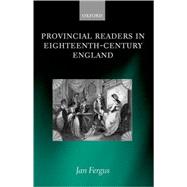Provincial Readers in Eighteenth-century England
, by Fergus, Jan- ISBN: 9780199297825 | 0199297827
- Cover: Hardcover
- Copyright: 3/29/2007
Many scholars have written about eighteenth-century English novels, but no one really knows who read them. This study provides historical data on the provincial reading publics for various forms of fiction--novels, plays, chapbooks, children's books, and magazines. Archival records of Midland booksellers based in five market towns and selling printed matter to over thirty-three hundred customers between 1744 and 1807 form the basis for new information about who actually bought and borrowed different kinds of fiction in eighteenth-century provincial England. This book thus offers the first solid demographic information about actual readership in eighteenth-century provincial England, not only about the class, profession, age, and sex of readers but also about the market of available fiction from which they made their choices--and some speculation about why they made the choices they did. Contrary to received ideas, in the provinces were the principal customers for eighteenth-century novels, including those written by women. Provincial customers preferred to buy rather than borrow fiction, and women preferred plays and novels written by women--women's works would have done better had women been the principal consumers. That is, demand for fiction (written by both men and women) was about equal for the first five years, but afterward the demand for women's works declined. Both men and women preferred novels with identifiable authors to anonymous ones, however, and both boys and men were able to cross gender lines in their reading.Goody Two-Shoeswas one of the more popular children's books among Rugby schoolboys, and men read theLady's Magazine. These and other findings will alter the way scholars look at the fiction of the period, the questions asked, and the histories told of it.







